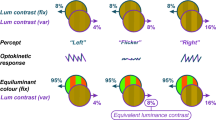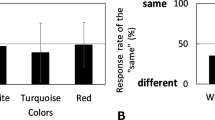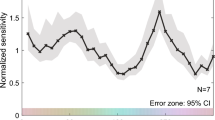Abstract
IN conjunction with my other methods of testing colour vision, I have been using Rayleigh's apparatus for matching yellow with a mixture of spectral red and green. I find that the proportions of red and green depend upon the luminosity of the match (both the mixed colour and the simple one being of similar luminosity); for instance, I require two and a half times as much green in the mixed colour when the match is bright compared with a match at a lower luminosity. Some persons make a match which is nearly the same at several luminosities, others require more and more green as the luminosity is diminished, and others when the luminosity is diminished cannot make a match at all. So three normal sighted persons may make a similar match at one luminosity, and at another one may appear to be an anomalous trichromatic and the other colour blind. I find that a colour blind person (a dichromic with considerable shortening of the red end of the spectrum) may make a match like a normal sighted one.
This is a preview of subscription content, access via your institution
Access options
Subscribe to this journal
Receive 51 print issues and online access
$199.00 per year
only $3.90 per issue
Buy this article
- Purchase on SpringerLink
- Instant access to full article PDF
Prices may be subject to local taxes which are calculated during checkout
Similar content being viewed by others
Author information
Authors and Affiliations
Rights and permissions
About this article
Cite this article
EDRIDGE-GREEN, F. Luminosity and Colour. Nature 72, 222 (1905). https://doi.org/10.1038/072222b0
Issue date:
DOI: https://doi.org/10.1038/072222b0



